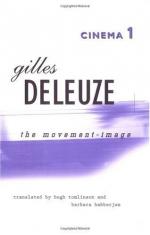
|
| Name: _________________________ | Period: ___________________ |
This test consists of 15 multiple choice questions and 5 short answer questions.
Multiple Choice Questions
1. In addition to movement, a track shot incorporates which of the following?
(a) Unity.
(b) Equilibrium.
(c) Cutting.
(d) Duration.
2. What does Deleuze say places images in consciousness?
(a) Concentration of image.
(b) Identity of image.
(c) Setting of image.
(d) Shadow of image.
3. What was the first book about film written by Deleuze?
(a) Shots 1.
(b) Cinema 1.
(c) Film 1.
(d) Philosophy 1.
4. What are the two poles in "The Perception Image"?
(a) Objective and subjective.
(b) Distance and boundaries.
(c) Idealism and materialism.
(d) Liquid and reume.
5. Who claimed that consciousness is "of" something?
(a) Husserl.
(b) Bergson.
(c) Keaton.
(d) Griffith.
6. Which type of frame occurs when an image passes to the equilibrium?
(a) Saturated frame.
(b) Rarefied frame.
(c) Demonstrational frame.
(d) Spatial frame.
7. What is the first pole of the face as Deleuze describes it?
(a) Quantity.
(b) Power.
(c) Subjectivity.
(d) Individuality.
8. What does "cogito" mean?
(a) I think.
(b) I feel.
(c) I am.
(d) I say.
9. Movement's first subdivision is into which category?
(a) Small-images.
(b) Movement-images.
(c) Perception-images.
(d) Dimension-images.
10. What term is used to designate a frame that isolates and solidifies an image?
(a) Objectivity.
(b) Dicisign.
(c) Reume.
(d) Point to point.
11. Deleuze describes which country as using more light as movement?
(a) Germany.
(b) USA.
(c) Japan.
(d) France.
12. What country does Deleuze credit with quantitative trends?
(a) France.
(b) Germany.
(c) USA.
(d) Soviet Union.
13. What does Deleuze say has objective and subjective dimensions?
(a) Affective factors.
(b) Film.
(c) Sensory factors.
(d) Perception.
14. Which of the following describes a soft camera focus?
(a) Modified factor.
(b) Active factor.
(c) Affective factor.
(d) Sensory factor.
15. Deleuze says that image is movement in the same way that matter is which of the following?
(a) Shadow.
(b) Light.
(c) Perception.
(d) Action-image.
Short Answer Questions
1. French filmmakers use machines to bring animate things together with which other type of things?
2. What shows the change from one view to another?
3. In what film is there a subjective view of a pipe through damaged eyes?
4. Which of the following was a film by Gance?
5. The view of a participating character is which of the following images?
|
This section contains 336 words (approx. 2 pages at 300 words per page) |

|




